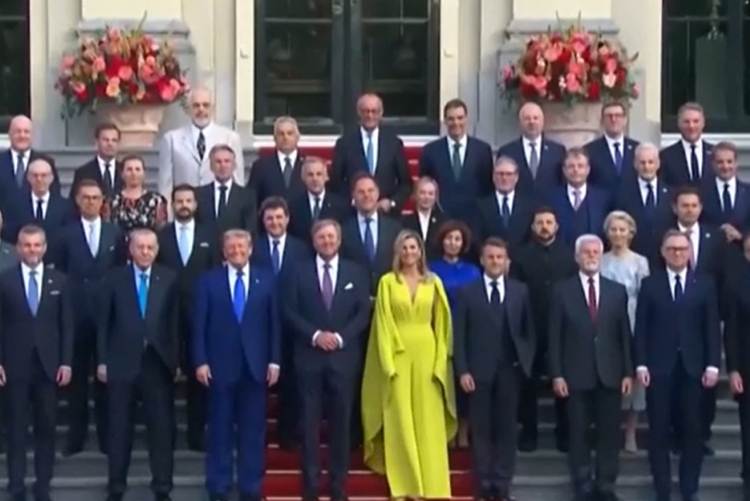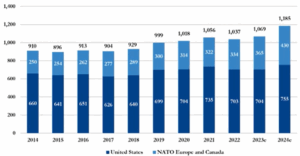
The headline from The Hague—NATO pledges to spend 5 per cent of GDP on defence by 2035—looks like the moment Europe finally shoulders its own security burden. On closer inspection, the promise is a politically driven misallocation of scarce resources. Western dominance, eroded by deeper economic, technological and demographic forces, will not be restored by inflating military budgets; the single metric merely diverts attention from the real sources of power.
A round number is not a war plan. Only Poland and the Baltic states hover near the 5 per cent mark, while the United States itself spends about 3.4 per cent. Were every NATO member to meet even the core-defence slice of 3.5 per cent today, alliance outlays would rise by roughly $400 billion, pushing the annual bill towards $1.75 trillion. Yet the communiqué sets no hard targets for force composition, readiness or interoperability, confirming Todd Harrison’s warning that “budget has been put ahead of strategy.”
READ I BRICS summit to put local currencies at the heart of trade
Butter, guns and ageing societies
Europe’s fiscal space is narrower than at any point since the euro-crisis years. Ageing alone will lift pension and health outlays well beyond four percentage points of GDP by 2030 in Germany, Italy and Spain. Diverting three-quarters of a trillion euros into armour and air defence risks crippling social investment and climate-transition budgets already overdue. Finance ministries have begun planning creative accounting to re-label highways, cyber projects and even Sicily’s planned Strait bridge as defence-related spending—hardly a recipe for deterrence or public trust.
Defence spending by NATO in $ billion

Even a fully funded European build-up cannot halt Asia’s rise. Over the past decade, the Indo-Pacific share of global military spending has climbed steadily, while NATO’s portion has slipped from nearly two-thirds to just over half. China spends a lower share of GDP than the United States yet extracts more steel, microchips and satellites per yuan than the West does per dollar. Last year, Asia-Pacific budgets grew in real terms by roughly the same pace as Europe’s post-Ukraine surge but from a lower cost base. Power measured by relative weight continues to drift eastward.
Technology will decide the contest
Dominance now hinges on micro-electronics, artificial intelligence, hypersonic delivery systems and secure supply chains. While Washington retains an edge in several domains, export controls and talent shortages gnaw at that lead; Europe trails even further behind. Analysts at CSIS argue that simultaneous flashpoints in the Indo-Pacific cannot be managed without allied help—assets most European capitals lack.
Heavy investment in legacy platforms—main-battle tanks and fifth-generation fighters—without an equivalent surge in semiconductor fabrication, rare-earth processing and quantum R&D risks a Maginot-style miscalculation: funding yesterday’s deterrent against tomorrow’s threats.
NATO: An alliance tugged in different directions
The pledge magnifies existing fissures. Spain has already signalled a ceiling of 2.1 per cent; Belgium and Slovakia call 5 per cent “impossible.” Nuclear-capable F-35s proposed for Estonia have provoked predictable Kremlin warnings, illustrating how uneven acquisition choices can drag the bloc toward escalation. Meanwhile, the summit communiqué shrank to 400 words—one-tenth the length of last year’s—because leaders could not agree on language condemning Russia’s invasion of Ukraine. A vow to spend offers scant compensation for the absence of political unity.
Western influence has long rested on trade access, development finance and rule-making, not just firepower. Beijing’s Belt and Road loans already top $1 trillion; its commerce with Latin America and Africa outstrips any European power’s. Siphoning tax euros from digital infrastructure in eastern and southern neighbourhoods into armoured brigades leaves the field open for Chinese 5G, port concessions and electric-vehicle supply chains. Military muscle unsupported by economic and normative sway is a brittle asset—as Afghanistan and Iraq so painfully demonstrated.
A smarter path to collective security
If global leadership is the goal, the alliance must restore the engines of growth and innovation. One percentage point of the proposed 5 per cent should be redirected into a joint resilience fund: 0.4 per cent for frontier technologies developed collaboratively; 0.3 per cent for critical-mineral and pharmaceutical supply chains; 0.3 per cent for green-energy deployment that cuts dependence on Russian hydrocarbons. Such rebalancing would placate defence hawks while signalling to the global South that Euro-Atlantic powers can still supply public goods beyond weaponry.
The Hague pledge was drafted to pacify a mercurial White House, not to regain strategic primacy. Bigger military budgets alone cannot halt the West’s gradual loss of influence. The wiser course is to treat 5 per cent as a ceiling, channel the difference into innovation funds and targeted infrastructure finance, and, above all, rebuild the economic magnetism that once made the transatlantic model aspirational.
Power in the twenty-first century will accrue to those who blend credible defence with technological leadership and developmental appeal. The West still possesses those assets—provided it resists the illusion that swagger in spending translates automatically into security or sustained dominance.
